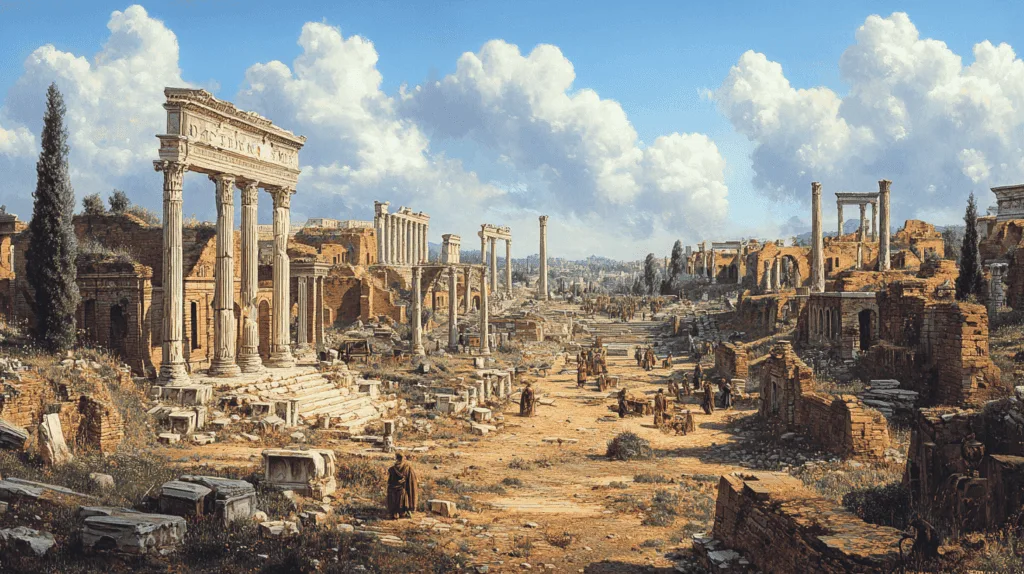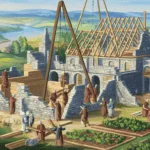
The fall of the Roman Empire led to several significant changes that contributed to the conditions often labeled as the “Dark Ages”.
Political fragmentation

The collapse of the Western Roman Empire led to a dramatic reshaping of the political landscape in Europe. As central Roman authority crumbled, numerous successor states emerged, each vying for power and territory. This fragmentation resulted in increased warfare and instability across the former empire. The Ostrogoths in Italy, Visigoths in Spain, Vandals in North Africa, and Franks in Gaul were among the major powers that arose.
These new kingdoms lacked the administrative sophistication of the Roman system, leading to more localized and often less stable forms of governance. The absence of a unifying political structure meant that conflicts between these states were common, further destabilizing the region and hampering economic recovery and cultural continuity.
Economic decline
The fall of Rome triggered a significant economic downturn across Western Europe. The loss of the Roman tax base, which had funded public works and services, led to the deterioration of infrastructure. Long-distance trade networks, which had flourished under Roman protection, were severely disrupted. This disruption led to a decline in specialized production and the disappearance of advanced economic structures.
The sophisticated Roman monetary system collapsed in many areas, leading to a return to barter economies in some regions. Urban centers, which had been hubs of economic activity, saw dramatic declines in population and commercial activity. The lack of a centralized economy and the fragmentation of markets led to a more localized and subsistence-based economic system in many areas.
Population decline
The period following the fall of Rome saw a substantial decrease in population across Western Europe. This decline was driven by several factors, including constant warfare, economic instability, and reduced agricultural productivity. The breakdown of Roman infrastructure and trade networks led to food shortages and famines.
Epidemics, such as the Justinian Plague in the 6th century, further decimated populations. Urban centers were particularly hard hit, with Rome’s population plummeting from around one million to just a few thousand shortly after the empire’s fall. This demographic collapse had far-reaching consequences, reducing the labor force, limiting economic recovery, and contributing to the overall decline in societal complexity.
Cultural shift
The disappearance of Roman bureaucratic careers led to a significant cultural shift in post-Roman Europe. Advanced literacy and classical education, which had been hallmarks of Roman society, declined sharply. For nearly 500 years, advanced literacy became largely confined to churchmen. This shift had profound implications for the preservation and transmission of knowledge.
Classical texts were often neglected or lost, and the focus of education narrowed, primarily serving ecclesiastical purposes. The decline in secular learning led to a reduction in scientific inquiry and philosophical discourse. However, monasteries became crucial centers for preserving some aspects of classical learning, albeit often with a Christian reinterpretation.
Militarization of society
The collapse of the professional Roman army led to a fundamental shift in military organization and social structure. Local landowners were now forced to provide military service, replacing the centralized Roman military system. This change altered the priorities of the elite class, who now had to focus on military preparedness alongside their traditional roles.
The rise of heavily armored cavalry became a defining feature of this period, leading to the development of feudal-like systems where military service was exchanged for land and protection. This militarization of society contributed to the development of the medieval knightly class and the eventual emergence of feudalism in many parts of Europe.
Technological regression
The fall of Rome led to a decline in technological innovation, particularly in non-military fields. The loss of specialized knowledge and economic resources meant that many advanced Roman technologies fell into disuse or were forgotten entirely. Complex engineering projects, such as aqueducts and large-scale architecture, became rare. The sophisticated Roman system of roads and bridges deteriorated due to lack of maintenance.
However, it’s important to note that this regression was not uniform across all fields or regions. Some areas, particularly those less affected by the collapse, maintained higher levels of technological sophistication. Additionally, new technologies did emerge during this period, often in response to changing societal needs.
Urban decay

The decline of urban centers was one of the most visible consequences of Rome’s fall. Many Roman cities saw dramatic population losses, with Rome itself experiencing a staggering decline from a population of around one million to just a few thousand shortly after the empire’s fall. This urban decay was driven by multiple factors, including the breakdown of trade networks, the loss of administrative functions, and security concerns.
Many cities shrank within their walls, with large areas becoming abandoned or used for agriculture. Public buildings and infrastructure fell into disrepair. However, some cities, particularly those that remained important religious or political centers, managed to maintain some of their urban character.
Rise of local power structures
The weakness of centralized authority following Rome’s fall led to the empowerment of local landowners and the creation of more feudal-like systems. In the absence of a strong central government, local elites took on increased roles in governance, justice, and defense. This shift laid the groundwork for the feudal system that would characterize much of medieval Europe. The relationship between lords and their dependents became more personal and localized, replacing the more impersonal and bureaucratic Roman system. This change had profound implications for social mobility, economic organization, and political power structures throughout the former Western Roman Empire.
Increased reliance on religion

As secular institutions weakened in the wake of Rome’s fall, the Church gained more prominence in social and political spheres. The Church often stepped in to fill the void left by the collapse of Roman administrative structures, providing a degree of continuity and stability. Monasteries became centers of learning and cultural preservation.
The Church’s role in education, healthcare, and social services expanded significantly. This increased religious influence shaped many aspects of post-Roman society, from law and governance to art and architecture. However, it’s important to note that this process was gradual and varied across different regions of the former empire.
Loss of written records
The decline in literacy and the collapse of centralized record-keeping led to a significant reduction in written sources from this period, contributing to its “dark” label. The loss of the Roman bureaucratic system meant that many types of documents that had been routinely produced and preserved were no longer created. The decline in secular education resulted in fewer people capable of producing and understanding complex written works.
Many classical texts were lost or survived only in fragmentary form. This scarcity of written records has made it challenging for historians to fully understand this period, leading to many of the misconceptions about the “Dark Ages”. However, recent archaeological discoveries and new interpretations of existing sources have begun to shed more light on this complex era.




